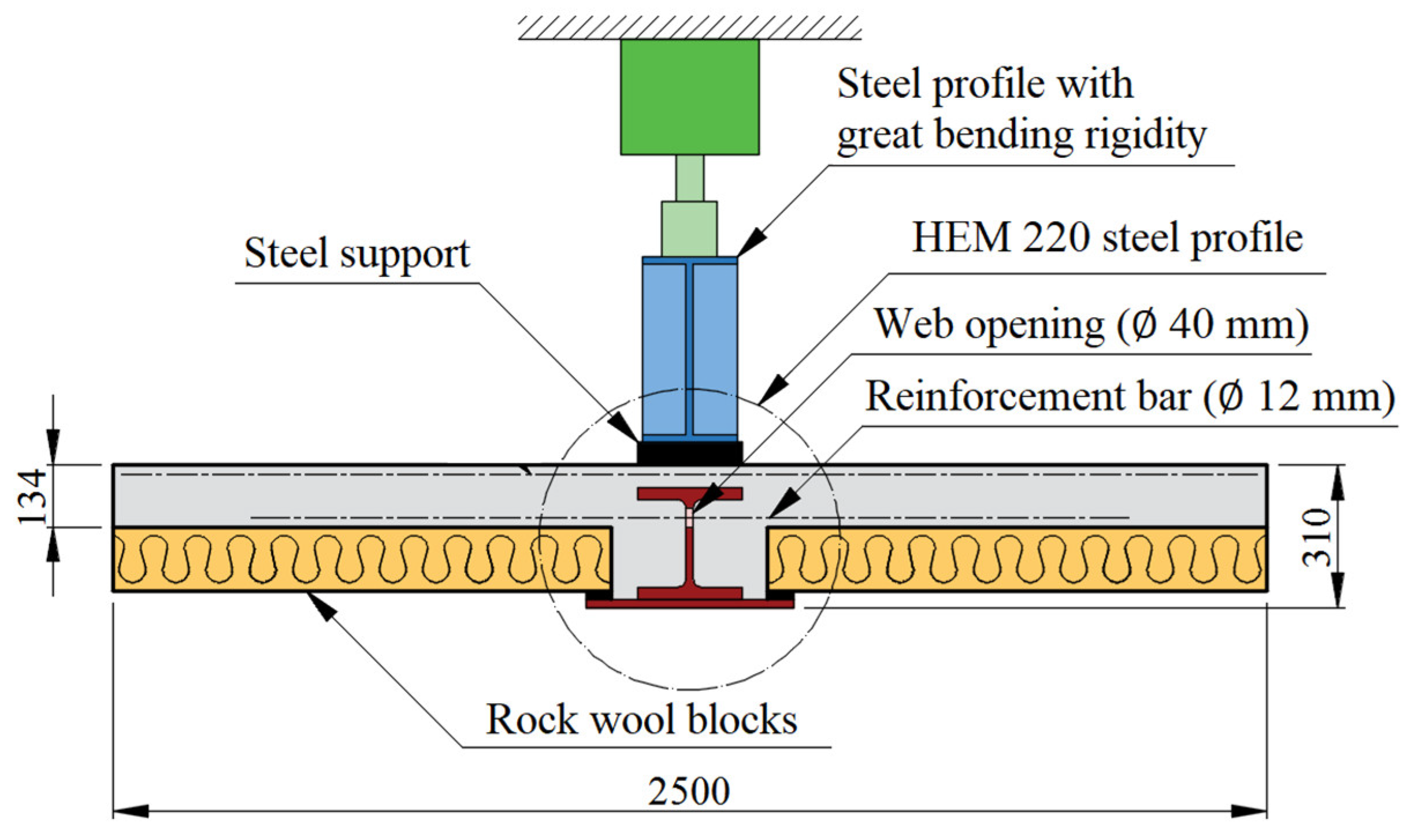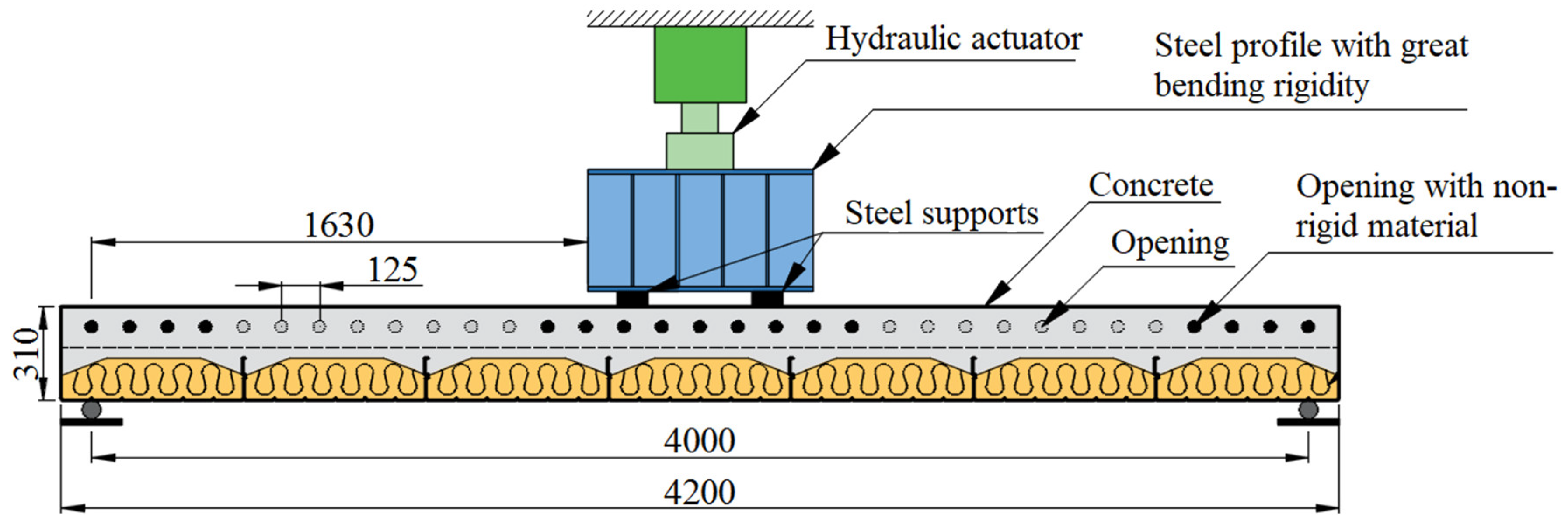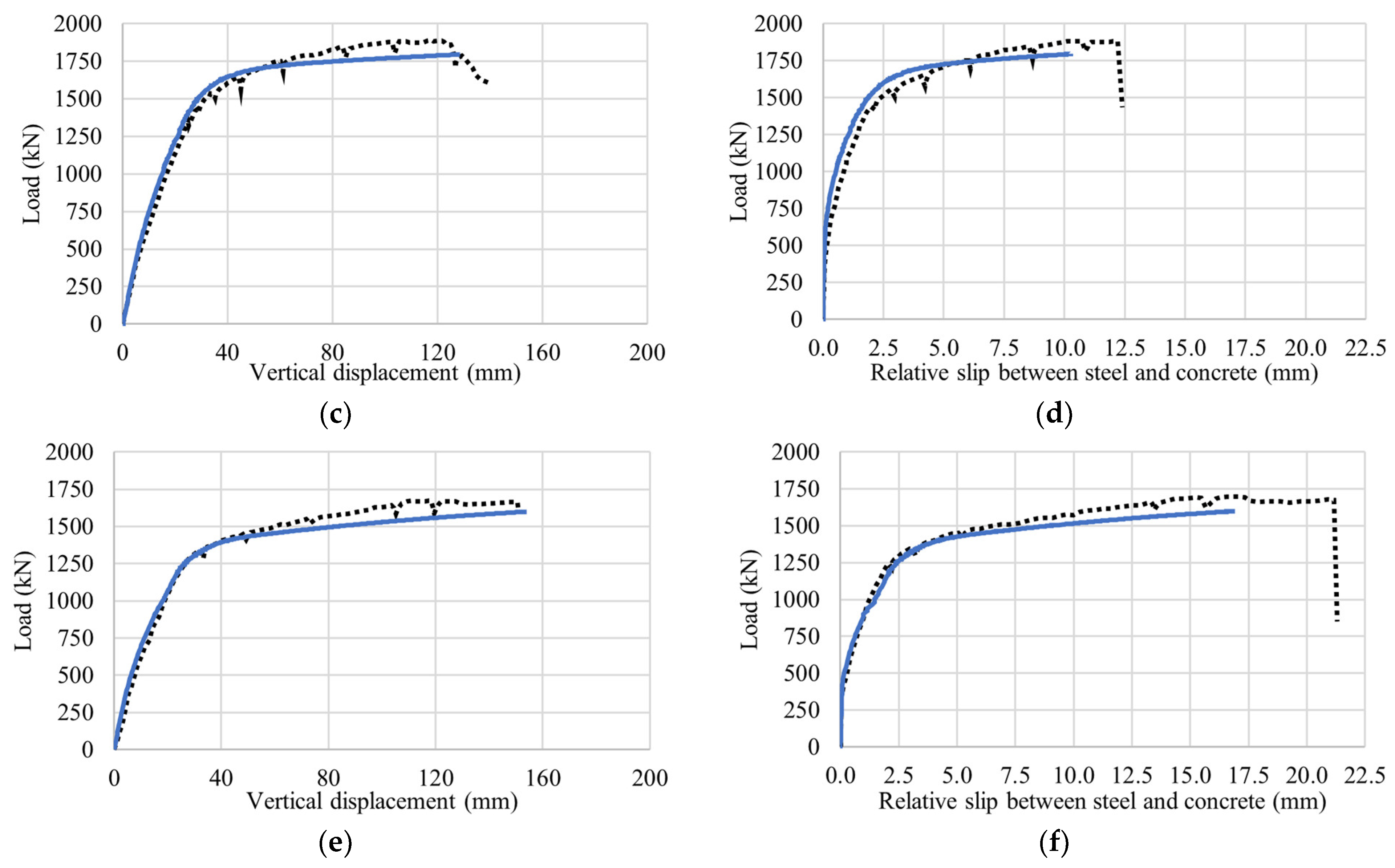Evaluation of the Structural Behavior of Composite Slim-Floor Beams with Openings in the Web †
Abstract
:1. Introduction
2. Materials and Methods
2.1. Development of the FE Models
2.1.1. Geometry and Structural Characteristics of Experimental Prototypes
2.1.2. Considerations about the FE Models
2.2. Parametric Study
3. Results and Discussion
3.1. Validation of the FE Models
3.2. Influence of the Connection Mechanisms
4. Conclusions
Author Contributions
Funding
Institutional Review Board Statement
Informed Consent Statement
Data Availability Statement
Conflicts of Interest
References
- Oguejiofor, E.C.; Hosain, M.U. A parametric study of Perfobond rib shear connectors. Can. J. Civ. Eng. 1994, 21, 614–625. [Google Scholar] [CrossRef]
- Verissimo, G.S.; Valente, M.I.B.; Paes, J.L.R.; Cruz, P.J.S.; Fakury, R.H. Design and experimental analysis of a new shear connector for steel and concrete composite structures. In Proceedings of the 3rd International Conference on Bridge Maintenance, Safety and Management, Porto, Portugal, 16–19 July 2006; pp. 68–72. [Google Scholar]
- Paes, J.L.R. Aportaciones al Análisis del Comportamiento Estructural de Sistema Forjados Mixtos Tipo “Slim floor”. Ph.D. Thesis, Universitat Politècnica de Catalunya, Barcelona, Spanish, 2003. [Google Scholar]
- Lawson, R.M.; Mullett, D.L.; Rackham, J.W. Design of Asymmetric Slimflor Beams Using Deep Composite Decking; SCI Publication P175; The Steel Construction Institute: Ascot, UK, 1997. [Google Scholar]
- Leskelä, M.V.; Hopia, J. Steel Sections for Composite Shallow Floors. Report RLT 0053E; University of Oulu, Structural Engineering Laboratory: Oulu, Finland, 2000. [Google Scholar]
- Braun, M.; Hechler, O.; Obiala, R.; Kuhlmann, U.; Eggert, F.; Hauf, G.; Konrad, M. Experimentelle Untersuchungen von Slim-Floor-Trägern in Verbundbauweise. Stahlbau 2014, 83, 741–749. [Google Scholar] [CrossRef]
- Wright, P.J. Slimdek—Development of an Integrated Floor System. Composite Construction. In Proceedings of the Conventional and Innovative International Conference, Innsbruck, Austria, 16–18 September 1997; pp. 343–347. [Google Scholar]







| Models | Connection Mechanisms |
|---|---|
| MC-M1-L8-IC | Complete interaction (no relative slip between steel and concrete) |
| MC-M2-L8-SI | No interaction (steel beam and concrete slab are considered isolated) |
| MC-M3-L8-PBA-RF | Three connection mechanisms: concrete dowel, reinforcing bars, and adherence |
| MC-M4-L8-PA | Two connection mechanisms: concrete dowel and adherence |
| MC-M5-L8-PB | Two connection mechanisms: concrete dowel and reinforcing |
| MC-M6-L8-A | One connection mechanism: adherence |
Disclaimer/Publisher’s Note: The statements, opinions and data contained in all publications are solely those of the individual author(s) and contributor(s) and not of MDPI and/or the editor(s). MDPI and/or the editor(s) disclaim responsibility for any injury to people or property resulting from any ideas, methods, instructions or products referred to in the content. |
© 2023 by the authors. Licensee MDPI, Basel, Switzerland. This article is an open access article distributed under the terms and conditions of the Creative Commons Attribution (CC BY) license (https://creativecommons.org/licenses/by/4.0/).
Share and Cite
Mesquita, L.C.; Marques, M.G.; Paes, J.L.R. Evaluation of the Structural Behavior of Composite Slim-Floor Beams with Openings in the Web. Eng. Proc. 2023, 53, 6. https://doi.org/10.3390/IOCBD2023-15181
Mesquita LC, Marques MG, Paes JLR. Evaluation of the Structural Behavior of Composite Slim-Floor Beams with Openings in the Web. Engineering Proceedings. 2023; 53(1):6. https://doi.org/10.3390/IOCBD2023-15181
Chicago/Turabian StyleMesquita, Leonardo C., Marília G. Marques, and José L. R. Paes. 2023. "Evaluation of the Structural Behavior of Composite Slim-Floor Beams with Openings in the Web" Engineering Proceedings 53, no. 1: 6. https://doi.org/10.3390/IOCBD2023-15181







